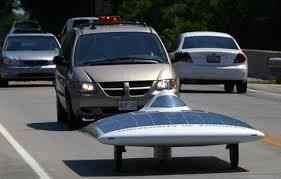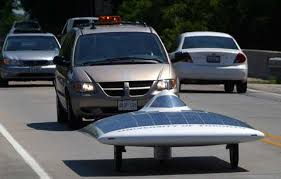
Solar powered cars running at night or even on cloudy days can be a reality after all. Scientists discovered a way to create compact fuel cells that use the power of the sun to generate hydrogen.
This, according to scientists would help increase the efficiency of a solar cell ten times than is possible at present.
Scientists have developed a technology to split water into its constituent elements – hydrogen and oxygen using the sun’s energy. The hydrogen produced by the splitting of water with suns energy would enable running of solar powered cars even at night time, which is a hindrance to the rampant use of solar powered vehicles. Hydrogen that would be produced would serve as the fuel for driving the solar powered vehicle. This technology would be a viable alternative to the traditional fossil fuels. Scientists have termed this as 'solar fuel'.
Another advantage of the new technology is the marginal use of gallium phosphide. The technology would enable generation of solar power with less than ten thousand times less gallium phosphide than used in modern solar panels.
“For the nanowires we needed ten thousand less precious gallium phosphide material than in cells with a flat surface. That makes these kinds of cells potentially a great deal cheaper”, said Professor Erik Bakkers, a nanoscientist at Delft University of Technology in Delft, the Netherlands, who led the research work.
The prime hindrance to the commercial production of hydrogen from water using solar energy has been the insufficient quantity of hydrogen produced and the huge costs involved compared to the quantity of energy produced from solar powers.
Prior to the use of gallium phosphide in solar panels, silicon based semiconductors was used to generate electricity from the sun.
Earlier technologies have been able to store sun’s energy through solar panels in a battery. The energy is stored up until there is enough to split the water into hydrogen and oxygen. But such technology lacked practicability as the technology apparatus were heavy for vehicles.
The new technology, details of which were published in the journal ‘Nature Communications’ used 500 nanometres long and 90 nanometres thick wires made of gallium phosphide woven together in the form of a grid.
It is the gallium phosphide that has the capability of converting sunlight into electricity and then splitting the water in one instrument resulting in a compact solar fuel cell.
Electricity is released from the cell by the fusion of hydrogen and oxygen back to water in the cell itself.
This dual conversion technology is enabled in a single compact solar cell and hence increases the compactness of the energy cell and makes it fit to be mounted for use in cars and other vehicles.
Moreover, the direct splitting of the water and could boost the yield of hydrogen by a factor of ten where 2.9 percent of the 2 water into is converted into hydrogen. The researchers are however striving to increase this yield to 15 percent conversion to increase the utility of the cells further.
This technological development has led to the possibility of it being used by vehicles to travel even during the night after having stored up the energy in the form of split hydrogen and oxygen during the day. This has also eliminated the hindrance of solar powered vehicles that relied on transformation of solar power directly to electricity for running vehicles, not being able to run without sunlight.
(Source: www.dailymail.co.uk)
This, according to scientists would help increase the efficiency of a solar cell ten times than is possible at present.
Scientists have developed a technology to split water into its constituent elements – hydrogen and oxygen using the sun’s energy. The hydrogen produced by the splitting of water with suns energy would enable running of solar powered cars even at night time, which is a hindrance to the rampant use of solar powered vehicles. Hydrogen that would be produced would serve as the fuel for driving the solar powered vehicle. This technology would be a viable alternative to the traditional fossil fuels. Scientists have termed this as 'solar fuel'.
Another advantage of the new technology is the marginal use of gallium phosphide. The technology would enable generation of solar power with less than ten thousand times less gallium phosphide than used in modern solar panels.
“For the nanowires we needed ten thousand less precious gallium phosphide material than in cells with a flat surface. That makes these kinds of cells potentially a great deal cheaper”, said Professor Erik Bakkers, a nanoscientist at Delft University of Technology in Delft, the Netherlands, who led the research work.
The prime hindrance to the commercial production of hydrogen from water using solar energy has been the insufficient quantity of hydrogen produced and the huge costs involved compared to the quantity of energy produced from solar powers.
Prior to the use of gallium phosphide in solar panels, silicon based semiconductors was used to generate electricity from the sun.
Earlier technologies have been able to store sun’s energy through solar panels in a battery. The energy is stored up until there is enough to split the water into hydrogen and oxygen. But such technology lacked practicability as the technology apparatus were heavy for vehicles.
The new technology, details of which were published in the journal ‘Nature Communications’ used 500 nanometres long and 90 nanometres thick wires made of gallium phosphide woven together in the form of a grid.
It is the gallium phosphide that has the capability of converting sunlight into electricity and then splitting the water in one instrument resulting in a compact solar fuel cell.
Electricity is released from the cell by the fusion of hydrogen and oxygen back to water in the cell itself.
This dual conversion technology is enabled in a single compact solar cell and hence increases the compactness of the energy cell and makes it fit to be mounted for use in cars and other vehicles.
Moreover, the direct splitting of the water and could boost the yield of hydrogen by a factor of ten where 2.9 percent of the 2 water into is converted into hydrogen. The researchers are however striving to increase this yield to 15 percent conversion to increase the utility of the cells further.
This technological development has led to the possibility of it being used by vehicles to travel even during the night after having stored up the energy in the form of split hydrogen and oxygen during the day. This has also eliminated the hindrance of solar powered vehicles that relied on transformation of solar power directly to electricity for running vehicles, not being able to run without sunlight.
(Source: www.dailymail.co.uk)





